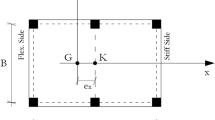Abstract
In this paper, different methods for generating synthetic earthquakes are compared in terms of related non-linear seismic response of ductile structures. The objective of the investigation is to formulate recommendations for the use of synthetic earthquakes for reliable seismic analysis. The comparison is focused on the accuracy of the reproduction of the characteristics of the structural non-linear response due to recorded earthquakes. First the investigations are carried out for non-linear single-degree-of-freedom systems. Later, the results are validated for a set of realistic buildings modelled as multi-degree-of-freedom systems. Various options of the classical stationary simulation procedure of SIMQKE and a non-stationary simulation procedure proposed by Sabetta and Pugliese are examined and compared. The adopted methodology uses a set of recorded earthquakes as a reference. Hundred synthetic accelerograms are generated for each examined simulation option with the condition that the related elastic responses are similar to those of the reference set. The non-linear single-degree-of-freedom systems are defined using six recognized hysteretic models and four levels of increasing non-linearity. The non-linear responses computed for the reference set and the studied simulation options are then statistically compared in terms of displacement ductility and energy. The results show that the implementation of the classical stationary procedure always leads to a significant underestimation of the ductility demand and a significant overestimation of the energy demand. By contrast, non-stationary time histories produce much better results. The results with the multi-degree-of-freedom systems are shown to confirm these conclusions.
Similar content being viewed by others
References
Allahabadi R, Powell GH (1988) Drain-2DX user guide. Report No. UCB/EERC-88/06. College of Engineering, University of California, Berkeley
Elenas A (2002) Seismic damage potential described by spectral intensity parameters. In Procceedings of the 12th european conference on earthquake engineering. Paper 267, London
Eurocode 8 (2004). Design of structures for earthquake resistance, part 1: general rules, seimic actions and rules for buildings, EN 1998-1; 2004. European Committee for Standardization (CEN), Brüssel
Federal Emergency Management Agency (FEMA 273). (1997) NEHRP Guidelines for the Seismic Rehabilitation of Buildings, Washington DC
Gasparini DA, Vanmarcke EH (1976) Simulated earthquake motions compatible with prescribed response spectra. MIT civil engineering research report R76-4. Massachusetts Institute of Technology, Cambridge, MA
Lestuzzi P, Badoux M (2003) The gamma-Model: A Simple Hysteretic Model For Reinforced Concrete Walls. Paper n° 126. In: Proceedings of the fib-symposium: concrete structures in seismic regions. Athens, Greece
Lestuzzi P, Schwab P, Koller M, Lacave C (2004) How to Choose Earthquake Recordings for Non-linear Seismic Analysis of Structures. In: Proceedings of 13th world conference on earthquake engineering. Vancouver, British Columbia, Canada
Litton RW (1975) A contribution to the analysis of concrete structures under cyclic loading. Civil Engineering Dept., University of California, Berkeley
Nassar AA, Krawinkler H (1991) Seismic demands for SDOF and MDOF systems research Report No. 95. The John A. Blume earthquake engineering Center. Department of Civil Engineering Stanford University, Stanford, California
Otani A (1974) Inelastic analysis of R/C frame structures. J Struct Div ASCE 100 (ST):1433– 1449
Saactioglu M (1991) Modeling hysteretic force deformation relationships for R/C elements. In: Earthquake-resistant concrete structures.: inelastic response and Design Special publication SP-127 of the American concrete institute (ACI). Detroit, Michigan
Sabetta F, Pugliese A (1996) Estimation of response spectra and simulation of nonstationary earthquake ground motions. Bull Seismol Soc Am 86(2):337–352
Saiidi M, Sozen MA (1981) Simple nonlinear seismic analysis of R/C structures. J Struct Div Proc Am Soc Civil Eng (ASCE) 107 (ST5): 937–952
Schwab P (2002) Influence of seismic characteristics on the dynamic nonlinear response of structures. Master thesis, Ecole Polytechnique Fédérale de Lausanne (EPFL), Switzerland
Smit P et al (2000) European Strong Motion Database. European Council, Environment and Climate Research Programme (CD-Rom)
Takeda T, Sozen MA, Nielsen NN (1970) Reinforced concrete response to simulated earthquakes. J Struct Div Proc Am Soc Civil Eng (ASCE) 96(ST12): 2557–2573
Valles RE, Reinhorn AM, Kunnath SK, Li C, Madan A (1996) IDARC 2D Version 4.0: a program for inelastic damage analysis of buildings. Technical Report NCEER-96-0010, State University of New York at Buffalo, NY
Author information
Authors and Affiliations
Corresponding author
Rights and permissions
About this article
Cite this article
Schwab, P., Lestuzzi, P. Assessment of the seismic non-linear behavior of ductile wall structures due to synthetic earthquakes. Bull Earthquake Eng 5, 67–84 (2007). https://doi.org/10.1007/s10518-006-9016-z
Received:
Accepted:
Published:
Issue Date:
DOI: https://doi.org/10.1007/s10518-006-9016-z




